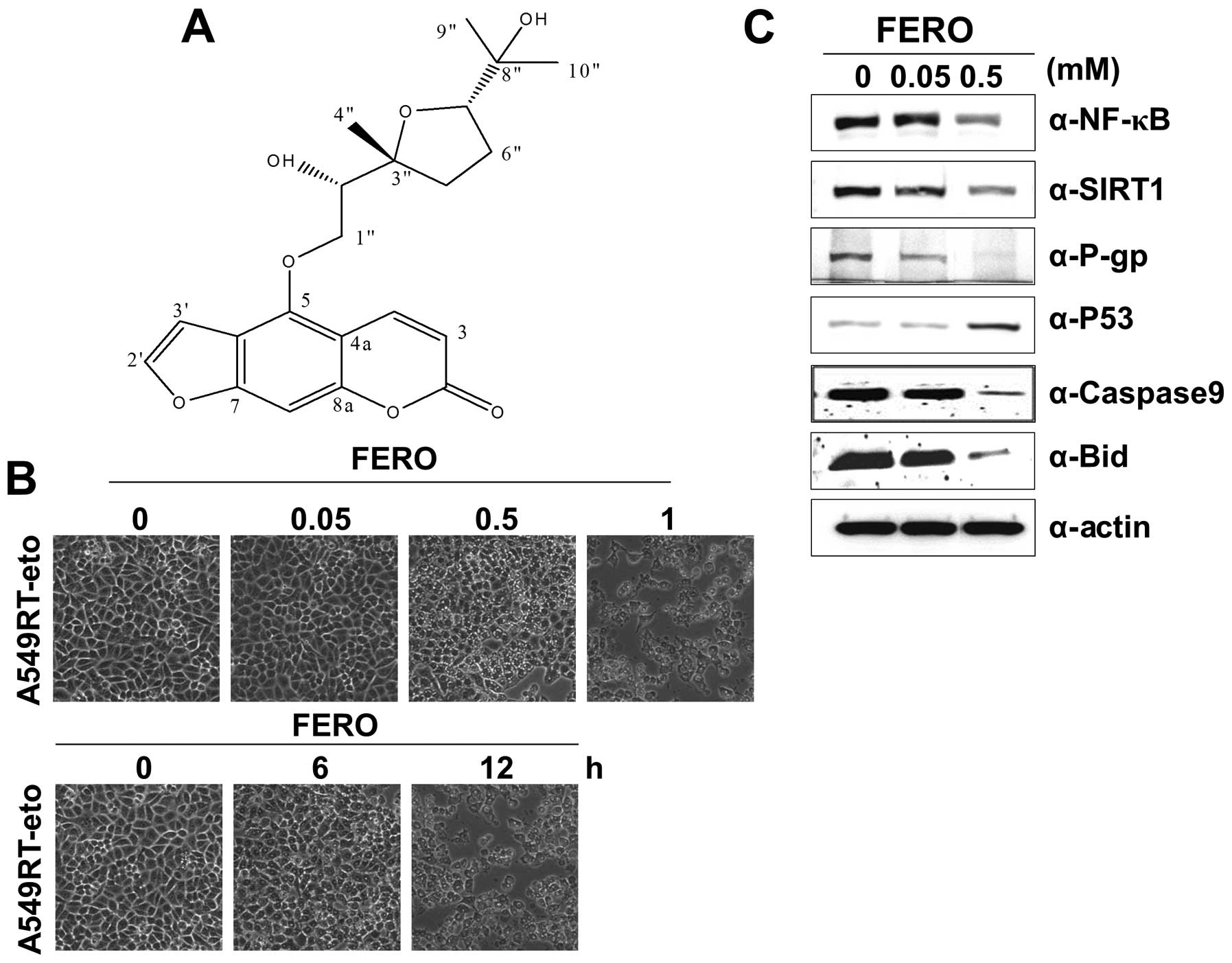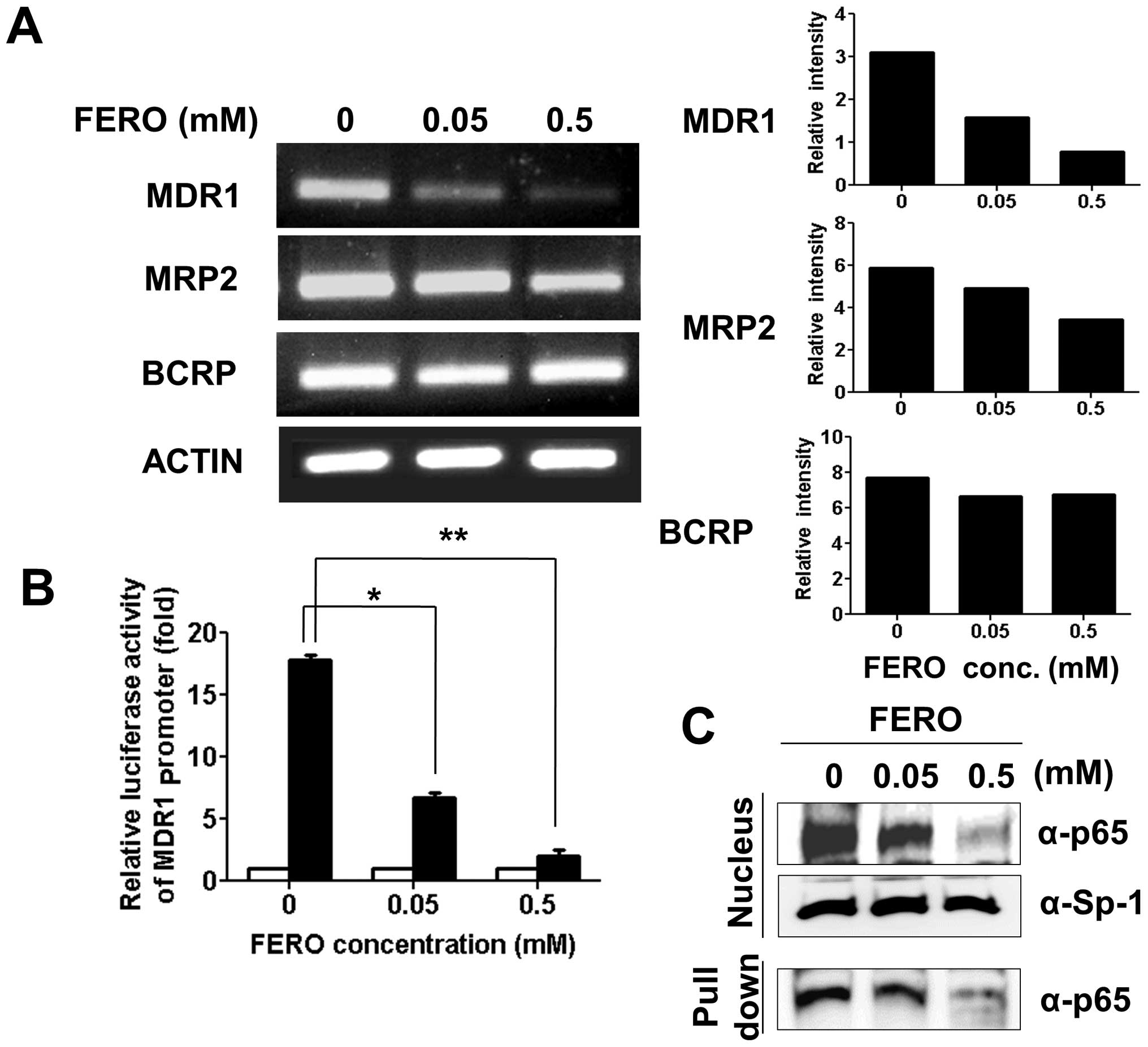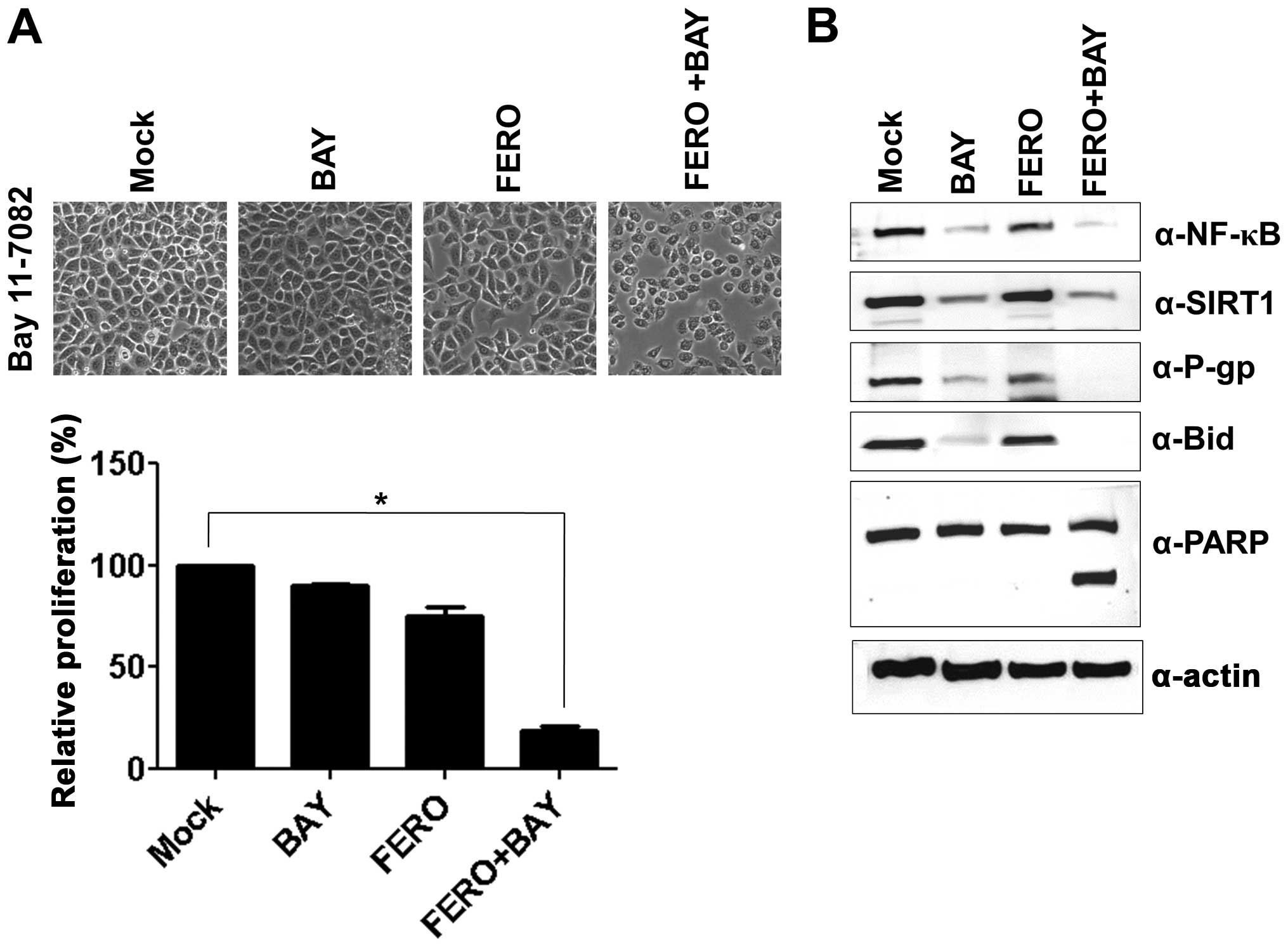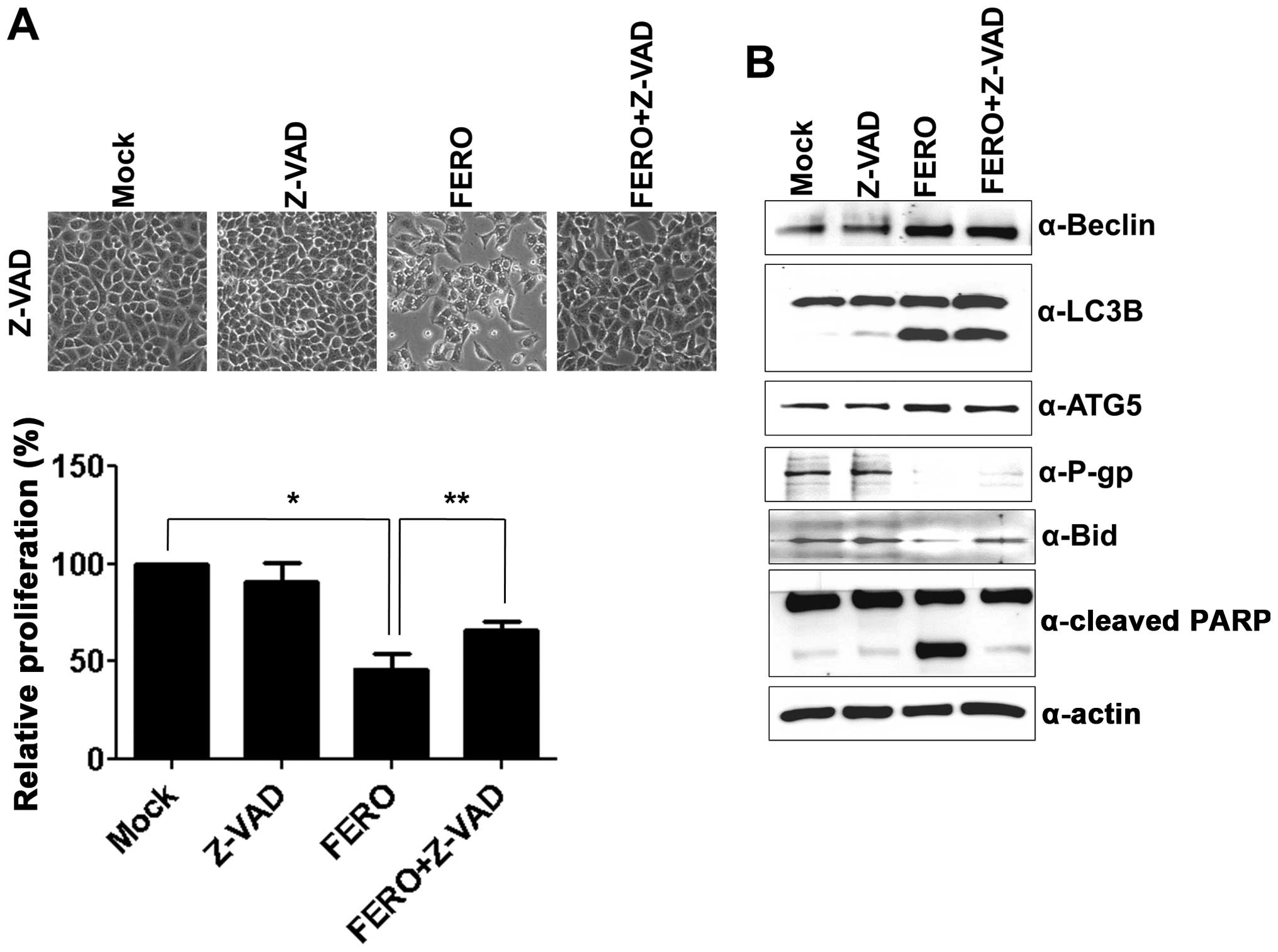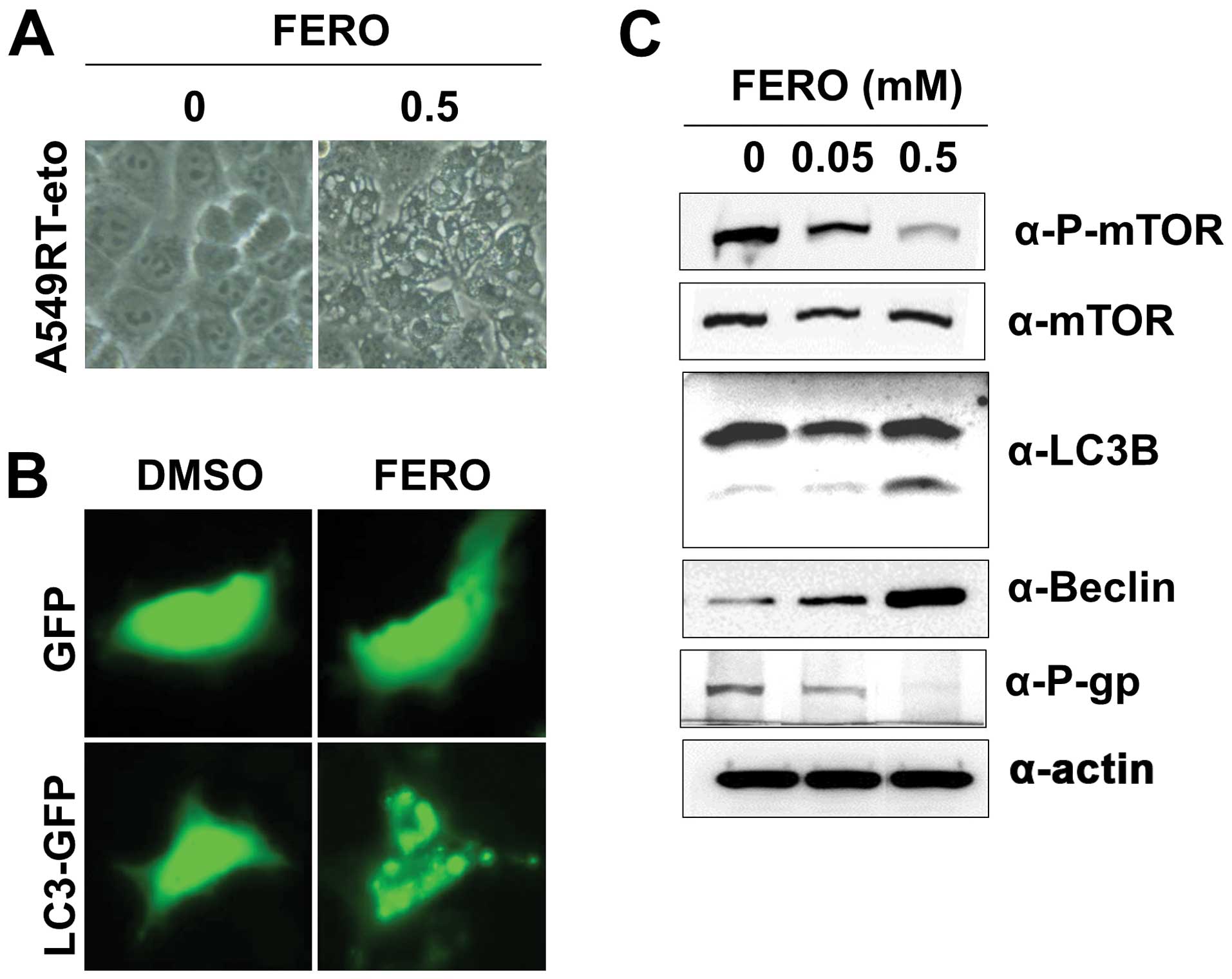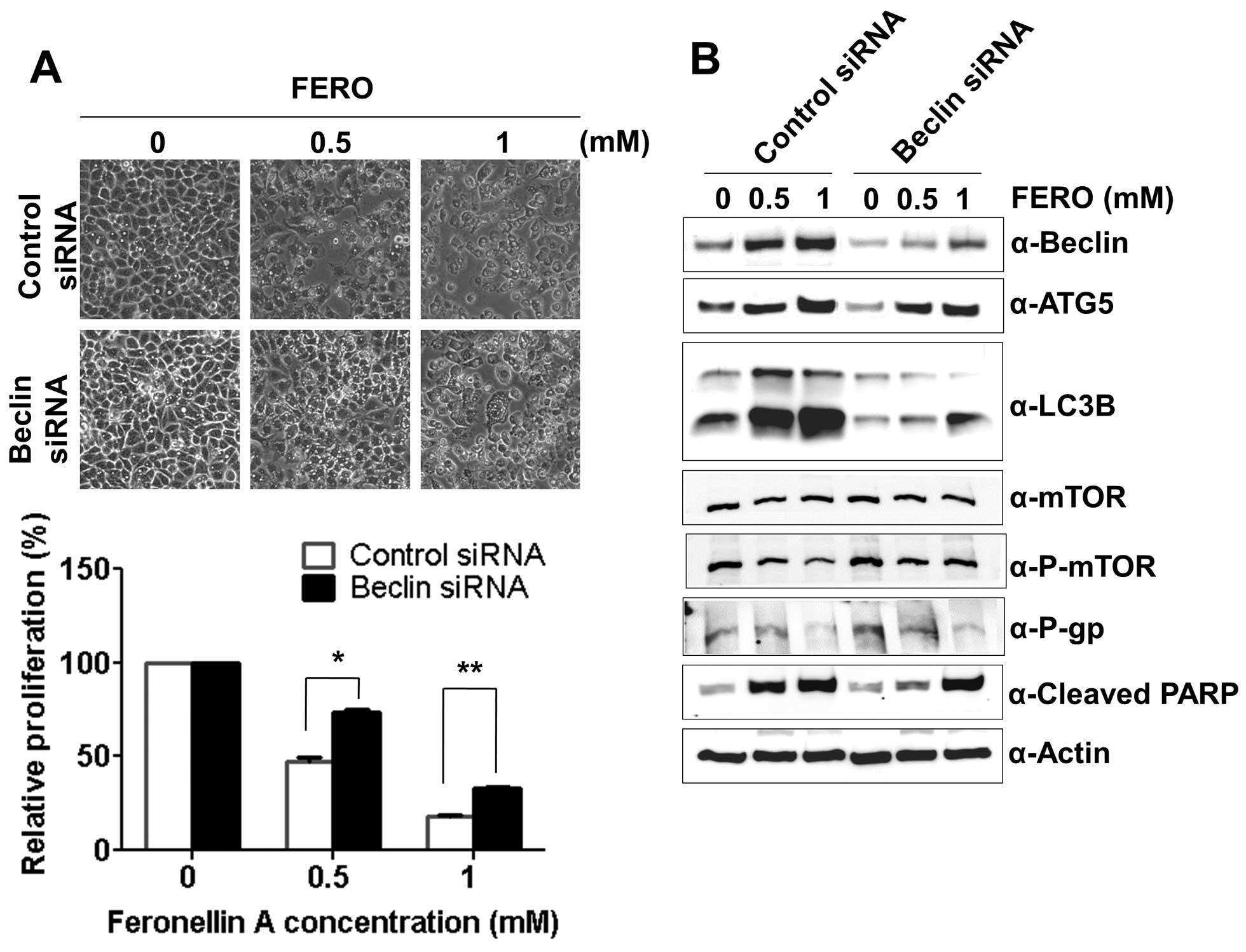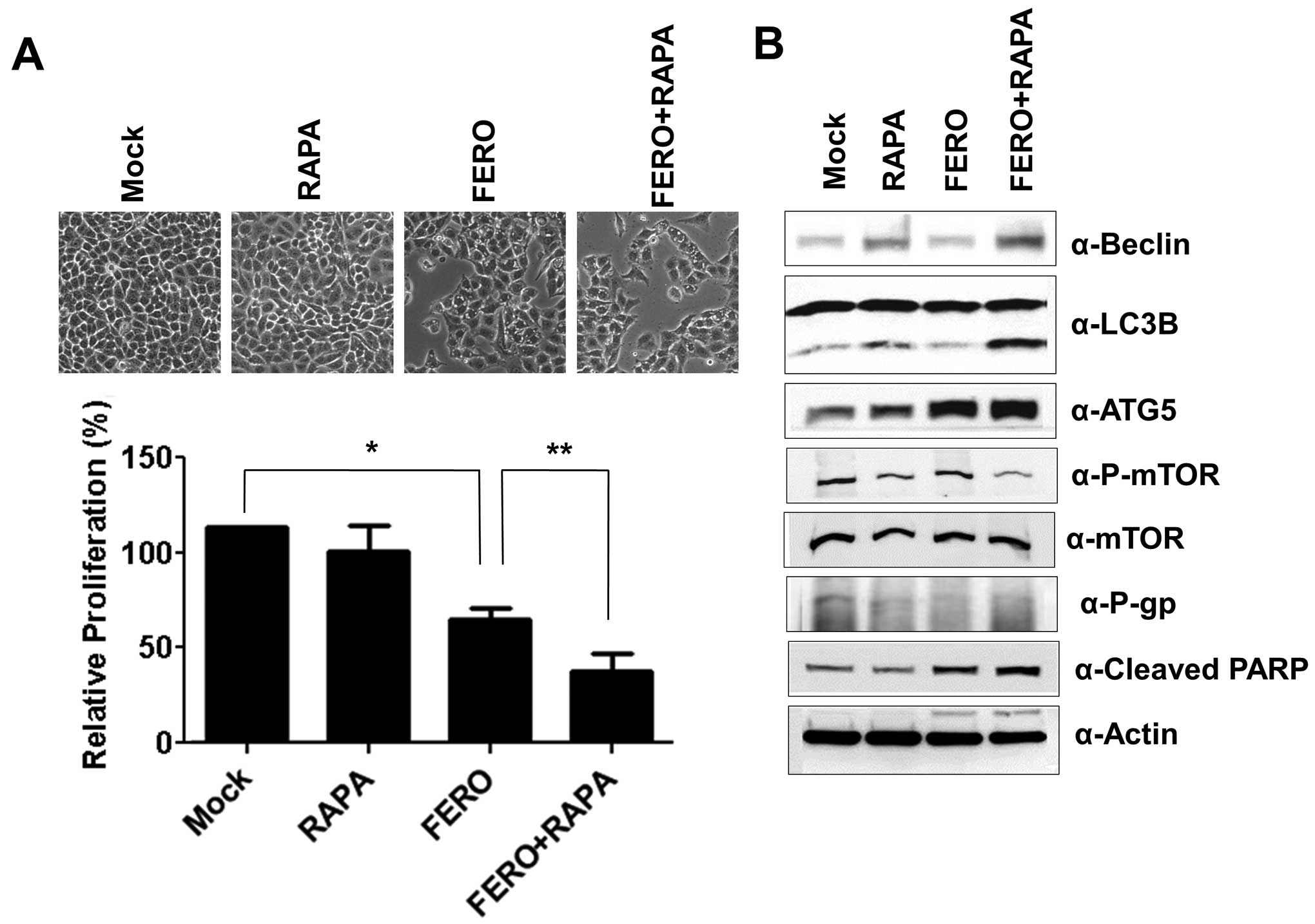Feroniellin A-induced autophagy causes apoptosis in multidrug-resistant human A549 lung cancer cells
- Authors:
- Published online on: February 11, 2014 https://doi.org/10.3892/ijo.2014.2297
- Pages: 1233-1242
Abstract
Introduction
Medicinal plants have proven to be a rich source of bioactive compounds for therapeutic agents, and currently 75% of prescribed drugs worldwide are derived from plant sources (1). Feroniellin A (FERO), a novel furanocoumarin is isolated from the roots of Feroniella lucida. The chemical structure of furanocoumarins consists of a furan ring fused with coumarin, which is present in many plants. Coumarins possess anticoagulant, antimicrobial, antioxidant, anti-inflammatory, anti-allergic and anticancer properties (2). Some furanocoumarin derivatives isolated from plants show anticancer activity by functioning as topoisomerase I inhibitors (3), efflux transport inhibitors or drug metabolism inhibitors (4,5). However, the specific molecular mechanisms by which FERO shows anticancer activity have not been revealed.
Multidrug resistance (MDR) is a major problem in cancer therapy and is often the result of overexpression of the drug efflux protein P-glycoprotein (P-gp). P-gp is a 170-kDa protein that belongs to the ATP-binding cassette superfamily of membrane transporter proteins (6,7). P-gp is an energy-dependent drug efflux pump that maintains intracellular drug concentrations below cytotoxic levels, thereby decreasing the cytotoxic effects of a variety of chemotherapeutic agents (6–9). P-gp also plays a role in inhibition of drug accumulation and caspase activation in MDR tumors (10,11). Of special note, recent lines of evidence have shown that NF-κB- or SIRT1-mediated regulation of P-gp plays a critical role in anticancer drug resistance (12,13).
Autophagy, an ancient system necessary to maintain homeostasis in eukaryotic cells, degrades long-lived cytoplasmic proteins and organelles and provides nutrients during starvation or stress conditions (14) through programmed processing involving the sequential activity of autophagy-related gene (ATG) products. As autophagy is necessary for cellular homeostasis, it is involved in biological processes including development, aging and degeneration (15). However, aberrant regulation of autophagy is related to many diseases, including cancer and neurodegenerative disorders (16). As a specific example, the first report connecting autophagy to cancer showed that allelic loss of the essential autophagy gene Beclin-1 (BECN1) is prevalent in human breast, ovarian, and prostate cancers (17), and that Becn1+/− mice develop mammary gland hyperplasia and lymphomas as well as lung and liver tumors (18). Subsequent studies demonstrated that ATG5−/− and ATG7−/− livers give rise to adenomas (19). These lines of evidence suggest that autophagy acts as a tumor suppressor in cancer development. Contrary to this, many other reports have shown that autophagy exerts a pro-survival function in tumor cells (20–22). Additional studies have demonstrated that the inhibition of autophagy by pharmaceutical drugs sensitized cells to apoptotic cell death, and that combination therapies using autophagy inhibitors plus chemotherapy led to faster tumor cell death than did chemotherapy alone (23). These findings indicate that pro-survival autophagy may represent a major hindrance to successful cancer therapy.
The present study was initiated to screen small molecules derived from plants grown in Thailand in order to reverse MDR in A549RT-eto cells. We have identified that FERO induces autophagy, which is necessary for FERO-induced apoptosis in A549RT-eto cells. Therefore, we propose that FERO represents a powerful candidate for the treatment of multidrug-resistant lung cancer.
Materials and methods
Cell cultures
A549RT-eto cells were developed and kindly provided by the Laboratory of Biochemistry, Chulabhorn Research Institute, Thailand and have been described elsewhere (24). A549RT-eto cells were cultured in RPMI-1640 medium (Gibco, Grand Island, NY, USA) supplemented with 10% FBS and 1% penicillin, and streptomycin (Gibco) at 37°C in a humidified atmosphere of 5% CO2 in air.
Antibodies and reagents
For immunoblotting, antibodies against ATG5, LC3B (D11), mTOR, phospho-mTOR (Ser2448) and cleaved PARP (Asp214) were acquired from Cell Signaling Biotechnology (Beverly, MA, USA). Anti-P-gp (Calbiochem; San Diego, CA, USA) and β-actin (C4), BECN1 (H300), BID (FL-195), caspase-9 p35 (H-170), NF-κB p65 (F-6), P53 (DO-1), SIRT1 (H-300) and Sp1 (1C6) antibodies were purchased from Santa Cruz Biotechnology (Santa Cruz, CA, USA). Rapamycin, Z-VAD and BAY11-7082 were purchased from Sigma-Aldrich (St. Louis, MO, USA). Feroniellin A was isolated from the roots of Feroniella lucida and was kindly provided by the Natural Products Research Unit, Department of Chemistry, Faculty of Science, Chulalongkorn University, Thailand and have been described elsewhere (25).
Immunoblotting
Cells were harvested and lysed with lysis buffer [150 mM NaCl, 1% NP-40, 50 mM Tris-HCl (pH 7.5)] containing 0.1 mM Na2VO3, 1 mM NaF and protease inhibitors (Sigma). For immunoblotting, proteins from whole cell lysates were resolved by 10 or 12% SDS-polyacrylamide gel electrophoresis (PAGE) and then transferred to nitrocellulose membranes. Primary antibodies were used at 1:1,000 or 1:2,000 dilutions, and secondary antibodies conjugated with horseradish peroxidase were used at 1:2,000 dilutions in 5% non-fat dry milk. After the final washing, nitrocellulose membranes were exposed using enhanced chemiluminescence assay and visualized on a LAS 4000 mini (Fuji, Tokyo, Japan).
Nuclear NF-κB pull-down assay
A549RT-eto cells (1×106 cells/ml) were incubated with FERO or DMSO as a control for 12 h and nuclear extracts were prepared. Cells were pelleted and resuspended in 0.4 ml hypotonic lysis buffer [20 mM HEPES (pH 7.9), 10 mM KCl, 1 mM EDTA, 0.2% Triton X-100, and 1 mM Na2VO3 plus protease inhibitors] and kept on ice for 20 min. After centrifugation at 14 000 g for 5 min at 4°C, the nuclear pellet was extracted with 0.1 ml hypertonic lysis buffer on ice for a further 20 min. After centrifugation at 14,000 g for 5 min at 4°C, the supernatants were diluted to 100 mM NaCl and incubated with 25 μl of agarose beads conjugated to a consensus NF-κB binding oligonucleotide (Santa Cruz Biotech) for 1 h at 4°C. After 3 washes, sample buffer was added and boiled for 5 min. The binding NF-κB (p65) protein to the oligonucleotide conjugated with agarose was detected by immunoblotting using an anti-p65 NF-κB Ab (Santa Cruz Biotech).
Small interfering RNA (siRNA) transfection
Cells were trypsinized and incubated overnight to achieve 60–70% confluency before siRNA transfection. Beclin-1 human siRNA (pre-made at Bioneer, Daejeon, Korea; 100 nM; sense: 5′-UGG AAU GGA AUG AGA UUA A(dTdT)-3′; antisense: 5′-UUA AUC UCA UUC CAU UCC A(dTdT)-3′ or negative control siRNA (Bioneer); 100 nM; sense: 5′-CCU ACG CCA CCA UUU CGU (dTdT)-3′; antisense: 5′-ACG AAA UUG GUG GCG UAG G (dTdT)-3′ were mixed with Lipofectamine 2000 (Invitrogen, Carlsbad, CA, USA). The cells were incubated with the transfection mixture for 24 h and then rinsed with RPMI-1640 medium containing 10% fetal bovine serum. The cells were incubated for 48 h before harvest.
Reverse-transcription polymerase chain reaction (RT-PCR)
Total RNA was extracted from cells using the RNeasy mini kit (Qiagen, Valencia, CA, USA) in accordance with the manufacturer’s instructions. Three micrograms of total RNA was converted to cDNA using Superscript II reverse transcriptase (Invitrogen), and PCR was performed using the specific primers: human MDR1, sense: 5′-CCC ATC ATT GCA ATA GCA GG-3′ and antisense: 5′-GTT CAA ACT TCT GCT CCT GA-3′; MRP2, sense: 5′-ACA GAG GCT GGT GGC AAC C-3′ and antisense: 5′-ACC ATT ACC TTG TCA CTG TCC-3′; BCRP, sense: 5′-GAT CAC AGT CTT CAA GGA GAT C-3′ and antisense: 5′-CAG TCC CAG TAC GAC TGT GAC A-3′ were used. The cDNAs from each sample were diluted, and PCR was run at an optimized cycle number. β-actin mRNA was measured as an internal standard. After amplification, the products were subjected to electrophoresis on 2.0% agarose gels and detected by ethidium bromide staining.
Luciferase reporter assay
A549RT-eto cells were transfected with hMDR1-luciferase or control pGL3 empty luciferase vector. To normalize transfection efficiency, a pGK-β-gal vector that expresses galactosidase from a phosphoglucokinase promoter was included in the transfection mixture. FERO was added to the transfected cells at 12 h before harvest. At 48 h post-transfection, cells were washed with cold PBS and lysed in lysis solution [25 mM Tris (pH 7.8), 2 mM EDTA, 2 mM DTT, 10% glycerol and 1% Triton X-100]. Luciferase activity was measured with a luminometer using a luciferase kit (Promega, Madison, WI, USA).
Cell viability assay
The 3-(4,5-dimethylthiazol-2-yl)-2,5-diphenyltetrazolium bromide (MTT) assay was performed to measure cell survival as described previously (26). Dye solution containing tetrazolium was added to cells in a 96-well plate format and incubated for 2 h. The absorbance of the formazan produced by living cells was measured at 570 nm. The relative percentage of cell survival was calculated by the mean absorbance of the treated cells (ODT) and the mean absorbance of control cells (ODC) following the formula: % Cell survival = (ODT / ODC).
Statistical analysis
Data are presented as a mean ± standard deviation (SD). Student’s t-test was used for statistical analysis, with significance defined as a p-value <0.05.
Results
Feroniellin A induces apoptosis in human A549 lung cells resistant to etoposide
Previous observations have revealed that human etoposide resistant A549 lung cancer cells (A549RT-eto) exhibit upregulation of Stat1 and HDAC4, leading to elevated levels of P-glycoprotein (P-gp) encoded by multidrug resistance (MDR) 1 (unpublished data). Thus, we performed a screen for small molecules derived from medicinal plants in Thailand that reverse MDR. We found that a small compound known as Feroniellin A (FERO; molecular weight = 388) (molecular structure shown in Fig. 1A) that efficiently induced death in A549RT-eto cells in a dose- and time-dependent manner (Fig. 1B). We found that parental A549 cells showed more cytotoxicity toward FERO as well (data not shown). Since it has been reported that NF-κB and SIRT1 are involved in the regulation of MDR through P-gp protein levels (27), we sought to examine protein levels of NF-κB, SIRT1 and P-gp in A549RT-eto cells treated with 0.05 and 0.5 mM FERO 12 h post-treatment. Our findings show that FERO treatment reduces expression levels of NF-κB, SIRT1 and P-gp and enhances expression levels of P53, a representative tumor suppressor protein (Fig. 1C). In addition, we detected reduced pre-caspase-9 and pre-Bid levels in the same lysates of A549RT-eto cells, indicating induction of intrinsic apoptosis (Fig. 1C).
Feroniellin A reduces MDR1 transcript levels and promoter activity in A549RT-eto cells
In addition to the MDR1 gene, other genes such as multidrug resistance-associated protein (MRP) 2 and breast cancer resistance protein (BCRP) are known to be involved in drug resistance (28,29). Therefore, we examined transcript levels of MDR1, MRP2 and BCRP in A549RT-eto cells during FERO treatment. RNA was isolated and cDNA generated from A549RT-eto cells treated with 0.05 and 0.5 mM FERO for 12 h and genes were amplified using an optimized number of cycles. We found a significant reduction in MDR1 transcript levels with slight reductions in MRP2 levels following FERO treatment in a dose-dependent manner (Fig. 2A). However, transcript levels of BCRP were not reduced by FERO treatment (Fig. 2B). In addition to transcript levels, we also examined MDR1 promoter activity in A549RT-eto cells during FERO treatment using an MDR1-promoter lucif-erase reporter vector (12). FERO treatment induced a dramatic decrease of MDR1-mediated luciferase activity in A549RT-eto cells (Fig. 2B), indicating that FERO reduces MDR1 promoter activity. Since it has been reported that the transcription factor NF-κB is involved in the regulation of P-gp (30,31), we next examined the nuclear localization of NF-κB and its DNA binding activity during FERO treatment. We found that FERO treatment inhibits translocation of NF-κB from the cytoplasm to the nucleus, which results in lowered levels of NF-κB at its binding site (Fig. 2C). On the basis of these results, we suggest that FERO inhibits MDR1 transcription, resulting in a decrease in P-gp protein levels, which leads to sensitization to apoptosis in A549RT-eto cells.
Inhibition of NF-κB accelerates FERO-induced apoptosis of A549RT-eto cells through downregulation of P-gp
Because we observed enhanced NF-κB protein levels and activity in A549RT-eto cells, we next explored whether NF-κB is involved in resistance to etoposide in A549 cells through upregulation of P-gp. A549RT-eto cells were treated with 10 μM BAY11-7082 (BAY), an inhibitor of NF-κB, and examined for cellular viability using the MTT assay. BAY treatment alone did not influence inhibition of cell growth in A549RT-eto cells, while 0.05 mM FERO treatment inhibited cell growth by ∼30% at 24 h post-treatment compared to DMSO controls (Fig. 3A). Furthermore, we found that a combined treatment of FERO and BAY accelerated FERO-mediated apoptosis in A549RT-eto cells (Fig. 3A), which was confirmed by observations of cleaved PARP and pre-Bid (Fig. 3B). Moreover, when we examined protein levels of NF-κB, SIRT1 and P-gp after treatment with BAY alone, FERO alone, or BAY plus FERO, we found that BAY treatment alone decreased not only expression levels of NF-κB but also P-gp, but did not influence protein levels of SIRT1 in the cells (Fig. 3B). FERO treatment alone was shown to drastically diminish protein levels of NF-κB, SIRT1 and P-gp in A549RT-eto cells (Fig. 1C). We also observed that the combined treatment resulted in more significantly reduced protein levels of NF-κB, SIRT1 and P-gp (Fig. 3B). These results suggest that NF-κB is involved in MDR in A549 cells by upregulation of P-gp, resulting in resistance to etoposide. To examine whether activation of caspase caused by FERO treatment is involved in apoptotic cell death in A549RT-eto cells, a pan-caspase inhibitor, Z-VAD, was used. FERO treatment alone at 0.5 mM resulted in a significant induction of apoptotic cell death at 24 h post-treatment, while the combined treatment with FERO and Z-VAD blocked FERO-induced apoptotic cell death (Fig. 4A), which was confirmed by a lack of cleavage of PARP and pre-Bid proteins (Fig. 4B). These results indicate that activation of caspases is involved in FERO-induced apoptotic cell death in A549RT-eto cells. However, Z-VAD treatment did not block downregulation of P-gp expression induced by FERO, indicating that a decrease of P-gp expression is necessary but not sufficient for apoptotic cell death.
FERO also induces autophagy in A549RT-eto cells
Auto-phagy has a dual role in cancer, as a tumor suppressor and a pro-tumor cell survival mechanism (32,33). Therefore, we investigated whether FERO could induce autophagy, which is characterized by the formation of vacuoles, GFP-LC3 puncta, and LC3 I to LC3 II conversion. The presence of vacuoles was apparent in A549RT-eto cells treated with 0.5 mM FERO (Fig. 5A). There was also a clearly observable accumulation of GFP-LC3 II puncta in A549RT-eto cells treated with FERO, while no GFP-LC3 puncta were present in A549RT-eto cells treated with DMSO (Fig. 5B). Moreover, we observed LC3 I to LC3 II conversion in FERO-treated A549RT-eto cells in a dose-dependent manner (Fig. 5C). Lastly, we found induction of Beclin-1, required for the formation of autophagic vesicles (34), and reduction of phospho-mTOR levels, an inhibitor of autophagy, indicating that FERO treatment clearly induced autophagy in A549RT-eto cells (Fig. 5C).
Modulation of autophagy regulates FERO-induced apoptosis in A549RT-eto cells
Expression of Beclin-1 is known to be essential for double-membrane autophagosome formation required during the initial steps of autophagy (34). Therefore, we tested whether autophagy impairment via the suppression of Beclin-1 hinders or accelerates FERO-induced apoptosis. We first determined the optimal siRNA concentration for suppression of Beclin-1 expression, which was found to be 100 nM (data not shown). FERO treatment with control siRNA induced apoptosis by activation of caspase-3 or -7 due to cleavage of PARP in a dose-dependent manner (Fig. 6A). Concomitantly, FERO induced autophagy coincided with an upregulation of Beclin-1 and ATG5, increased LC3 I to LC3 II conversion, and a reduction of phospho-mTOR levels in A549RT-eto cells. However, suppression of Beclin-1 with siRNA inhibited FERO-induced apoptosis, indicating that autophagy is necessary for FERO-induced apoptosis. Interestingly, we found that suppression of Beclin-1 by siRNA inhibited the conversion of LC3 I to LC3 II but did not inhibit upregulation of ATG5 expression induced by FERO. These results indicate that conversion of LC3 I to LC3 II occurs later and ATG5 mediated processes take place earlier than Beclin-1 mediated autophagy following FERO treatment (Fig. 6B). In addition, similar to the observation that Z-VAD suppresses FERO-induced apoptosis but does not block downregulation of P-gp, we also found that suppression of Beclin-1 does not block FERO-mediated decrease of P-gp expression despite the inhibition of FERO-induced apoptosis. This result indicates that downregulation of P-gp expression is necessary but not sufficient for the progression of apoptosis.
To verify that autophagy is necessary for FERO-induced apoptosis, we administered rapamycin (RAPA), an inhibitor of mammalian target of rapamycin (mTOR), in order to accelerate A549RT-eto cell autophagy in the presence of FERO (35,36). FERO induced apoptosis in A549RT-eto cells as well as dual administration of FERO and RAPA was observed to enhance apoptosis (Fig. 7A). Co-treatment of FERO and RAPA induced autophagy by upregulating Beclin-1 and ATG5 expression, and converting LC3 I to LC3 II (Fig. 7B). These results suggest that FERO-induced autophagy promotes apoptotic cell death in A549RT-eto cells.
Discussion
Presently, identification of effective chemotherapeutic agents in phytochemicals of great interest to cancer biologists, because of MDR in cancer cells, which are developed following prolonged treatment with anticancer drug. Feroniellin A (FERO) was reported to possess in vitro cytotoxicity in human KB carcinoma and HeLa carcinoma cells (25). However, the molecular mechanism by which this compound exerts cytotoxicity in these cancer cell lines is unknown. For the first time, we have provided a line of evidence showing that FERO reverses MDR1 activity by downregulation of NF-κB, which leads to enhanced apoptotic susceptibility in A549RT-eto cells. Consistent with our results, other studies have shown that metformin, mollugin, and puerarin, which are derived from plants also reverse MDR1 activity effectively through downregulation of NF-κB in human breast cancer cells resistant to adriamycin (30,37,38). Moreover, our study shows that inhibition of apoptosis with Z-VAD does not decrease P-gp expression, indicating that downregulation of P-gp is necessary but not sufficient for apoptosis. As SIRT1, β-catenin and HIF-1α have also been associated with MDR in many cancer models (39–41), we are currently investigating whether FERO affects the expression levels and activity of these proteins, rendering A549RT-eto cells susceptible to apoptosis.
Detailed reviews of autophagic progress can be found as described elsewhere (33,42). Briefly, autophagy is initiated by activation of the ATG1 complex, which includes ATG1/ATG13/ATG17, among other components. Next, autophagosome nucleation occurs, which requires class III phsophatidylinositol-3-kinase plus Beclin-1/ATG6 in addition to several other factors to recruit proteins and lipids involved in autophagosome formation. Vesicle elongation and completion are mediated by two-ubiquitin-like systems: ATG7 (E1-like) and ATG3 (E2-like), which are necessary for the lipid modification of LC3 (phosphatidylethanolamine; PE), which requires initial cleavage of LC3. Subsequently, the ATG12/ATG5/ATG16 complex mediates LC3-PE binding to the autophagosome membrane. Finally, the completed autophagosome fuses with lysosomes, where the autophago-some contents are degraded. We observed that suppression of Beclin-1 in the presence of FERO results in the inhibition of LC3 I to LC3 II conversion but does not inhibit ATG5 expression. Considering the sequential progress of autophagy, we assume that LC3 I to LC3 II conversion is very closely linked to Beclin-1 activity but that suppression of Beclin-1 itself does not affect FERO-induced ATG5 expression. Although we have observed that autophagy impairment such as Beclin-1 suppression with siRNA generated reactive oxygen species (ROS) (data not shown) as reported elsewhere (43,44), we also found that autophagy impairment with Beclin-1 suppression in fact protects cells from FERO-induced apoptosis. Based on this finding, we speculate that the amount of ROS generated by autophagy impairment does not influence aggravation of A49RT-eto cell survival. In addition, apoptosis inhibition with Z-VAD did not block FERO-induced autophagic progress such as upregulation of Beclin1 and ATG5, and converting LC3 I to LC3 II (Fig. 4B), indicating that autophagic progress is the upstream event of apoptosis.
Recently, autophagy inhibitors such as chloroquine (CQ) or hydroxychloroquine have been used in clinical trials because autophagy is believed to affect tumor survival (45–47). Therefore, it is possible that conventional chemotherapy with autophagy inhibitors may increase tumor cytotoxicity. In a mouse prostate cancer model, co-treatment with an Src family kinase inhibitor and CQ increased tumor cell numbers in vitro but reduced tumor cell growth in vivo (48). Conversely, since it has been suggested that autophagy also plays a role as a tumor suppressor, introduction of autophagy stimulants such as mTOR inhibitors with conventional chemotherapeutic drugs leads to accelerated tumor cell death compared to treatment with anti-cancer drugs alone (49,50). Since there are conflicting reports as to the positive and negative effects of autophagy on tumor cell death (32,33), the field needs to be cautious when attempting to manipulate autophagy to improve clinical outcomes. In conclusion, our study has demonstrated that FERO-induced autophagy is required for apoptotic progression and suggests that autophagy plays a role as a tumor suppressor in our model.
Acknowledgements
This study was supported by a grant from the World Class University Program (R31-2008-000-20004-0) through the National Research Foundation funded by the Korean government, and a grant from the Biomedical Fusion Technology Development Project of the Korea Research Institute of Bioscience and Biotechnology (KGM1231312). This study was also supported by the Office of the Higher Education Commission, Thailand, under the Strategic Scholarships Fellowships Frontier Research Networks (Specific for Southern region) for the Join PhD Program Thai Doctoral degree program; a CHE-SSR-PhD SW Scholarship to C.K.
References
|
Tan G, Gyllenhaal C and Soejarto DD: Biodiversity as a source of anticancer drugs. Curr Drug Targets. 7:265–277. 2006.PubMed/NCBI | |
|
Bronikowska J, Szliszka E, Jaworska D, Czuba ZP and Krol W: The coumarin psoralidin enhances anticancer effect of tumor necrosis factor-related apoptosis-inducing ligand (TRAIL). Molecules. 17:6449–6464. 2012. View Article : Google Scholar | |
|
Diwan R and Malpathak N: Furanocoumarins: novel topoisom-erase I inhibitors from Ruta graveolens L. Bioorg Med Chem. 17:7052–7055. 2009. View Article : Google Scholar : PubMed/NCBI | |
|
Ohnishi A, Matsuo H, Yamada S, et al: Effect of furanocoumarin derivatives in grapefruit juice on the uptake of vinblastine by Caco-2 cells and on the activity of cytochrome P450 3A4. Br J Pharmacol. 130:1369–1377. 2000. View Article : Google Scholar : PubMed/NCBI | |
|
Paine MF, Widmer WW, Hart HL, et al: A furanocoumarin-free grapefruit juice establishes furanocoumarins as the mediators of the grapefruit juice-felodipine interaction. Am J Clin Nutr. 83:1097–1105. 2006.PubMed/NCBI | |
|
Biedler JL: Drug resistance: genotype versus phenotype - Thirty-second G.H.A. Clowes Memorial Award Lecture. Cancer Res. 54:666–678. 1994.PubMed/NCBI | |
|
Bosch I and Croop J: P-glycoprotein multidrug resistance and cancer. Biochim Biophys Acta. 9:37–54. 1996. | |
|
Goldstein LJ, Galski H, Fojo A, et al: Expression of a multidrug resistance gene in human cancers. J Natl Cancer Inst. 81:116–124. 1989. View Article : Google Scholar : PubMed/NCBI | |
|
Gottesman MM, Fojo T and Bates SE: Multidrug resistance in cancer: role of ATP-dependent transporters. Nat Rev Cancer. 2:48–58. 2002. View Article : Google Scholar : PubMed/NCBI | |
|
Friedrich K, Wieder T, Von Haefen C, et al: Overexpression of caspase-3 restores sensitivity for drug-induced apoptosis in breast cancer cell lines with acquired drug resistance. Oncogene. 20:2749–2760. 2001. View Article : Google Scholar | |
|
Ruefli AA, Tainton KM, Darcy PK, Smyth MJ and Johnstone RW: P-glycoprotein inhibits caspase-8 activation but not formation of the death inducing signal complex (disc) following Fas ligation. Cell Death Differ. 9:1266–1272. 2002. View Article : Google Scholar : PubMed/NCBI | |
|
Bentires-Alj M, Barbu V, Fillet M, et al: NF-kappaB transcription factor induces drug resistance through MDR1 expression in cancer cells. Oncogene. 22:90–97. 2003. View Article : Google Scholar : PubMed/NCBI | |
|
Chu F, Chou PM, Zheng X, Mirkin BL and Rebbaa A: Control of multidrug resistance gene mdr1 and cancer resistance to chemotherapy by the longevity gene sirt1. Cancer Res. 65:10183–10187. 2005. View Article : Google Scholar : PubMed/NCBI | |
|
Klionsky DJ and Emr SD: Autophagy as a regulated pathway of cellular degradation. Science. 290:1717–1721. 2000. View Article : Google Scholar : PubMed/NCBI | |
|
Levine B and Klionsky DJ: Development by self-digestion: molecular mechanisms and biological functions of autophagy. Dev Cell. 6:463–477. 2004. View Article : Google Scholar : PubMed/NCBI | |
|
Levine B and Kroemer G: Autophagy in the pathogenesis of disease. Cell. 132:27–42. 2008. View Article : Google Scholar : PubMed/NCBI | |
|
Qu X, Yu J, Bhagat G, et al: Promotion of tumorigenesis by heterozygous disruption of the beclin 1 autophagy gene. J Clin Invest. 112:1809–1820. 2003. View Article : Google Scholar : PubMed/NCBI | |
|
Levine B: Cell biology: autophagy and cancer. Nature. 446:745–747. 2007. View Article : Google Scholar : PubMed/NCBI | |
|
Takamura A, Komatsu M, Hara T, et al: Autophagy-deficient mice develop multiple liver tumors. Genes Dev. 25:795–800. 2011. View Article : Google Scholar : PubMed/NCBI | |
|
Han J, Hou W, Goldstein LA, et al: Involvement of protective autophagy in TRAIL resistance of apoptosis-defective tumor cells. J Biol Chem. 283:19665–19677. 2008. View Article : Google Scholar | |
|
Katayama M, Kawaguchi T, Berger MS and Pieper RO: DNA damaging agent-induced autophagy produces a cytoprotective adenosine triphosphate surge in malignant glioma cells. Cell Death Differ. 14:548–558. 2007. View Article : Google Scholar | |
|
Li X and Fan Z: The epidermal growth factor receptor antibody cetuximab induces autophagy in cancer cells by downregulating HIF-1alpha and Bcl-2 and activating the beclin 1/hVps34 complex. Cancer Res. 70:5942–5952. 2010. View Article : Google Scholar : PubMed/NCBI | |
|
Ogata M, Hino S, Saito A, et al: Autophagy is activated for cell survival after endoplasmic reticulum stress. Mol Cell Biol. 26:9220–9231. 2006. View Article : Google Scholar : PubMed/NCBI | |
|
Kanintronkul Y, Worayuthakarn R, Thasana N, et al: Overcoming multidrug resistance in human lung cancer with novel benzo[α] quinolizin-4-ones. Anticancer Res. 31:921–927. 2011.PubMed/NCBI | |
|
Phuwapraisirisan P, Surapinit S, Sombund S, Siripong P and Tip-pyang S: Feroniellins A–C, novel cytotoxic furanocoumarins with highly oxygenated C10 moieties from Feroniella lucida. Tetrahedron Lett. 47:3685–3688. 2006. | |
|
Kaewpiboon C, Lirdprapamongkol K, Srisomsap C, et al: Studies of the in vitro cytotoxic, antioxidant, lipase inhibitory and antimicrobial activities of selected Thai medicinal plants. BMC Complement Altern Med. 12:2172012. View Article : Google Scholar | |
|
Jung YJ, Lee JE, Lee AS, et al: SIRT1 overexpression decreases cisplatin-induced acetylation of NF-kappaB p65 subunit and cytotoxicity in renal proximal tubule cells. Biochem Biophys Res Commun. 419:206–210. 2012. View Article : Google Scholar : PubMed/NCBI | |
|
Sugimoto Y, Tsukahara S, Ishikawa E and Mitsuhashi J: Breast cancer resistance protein: molecular target for anticancer drug resistance and pharmacokinetics/pharmacodynamics. Cancer Sci. 96:457–465. 2005. View Article : Google Scholar | |
|
Young LC, Campling BG, Cole SPC, Deeley RG and Gerlach JH: Multidrug resistance proteins MRP3, MRP1, and MRP2 in lung cancer: correlation of protein levels with drug response and messenger RNA levels. Clin Cancer Res. 7:1798–1804. 2001.PubMed/NCBI | |
|
Kim HG, Hien TT, Han EH, et al: Metformin inhibits P-glycoprotein expression via the NF-kappaB pathway and CRE transcriptional activity through AMPK activation. Br J Pharmacol. 162:1096–1108. 2011. View Article : Google Scholar : PubMed/NCBI | |
|
Sun J, Yeung CA, Co NN, et al: Clitocine reversal of P-glycoprotein associated multi-drug resistance through down-regulation of transcription factor NF-kappaB in R-HepG2 cell line. PLoS One. 7:e407202012. View Article : Google Scholar : PubMed/NCBI | |
|
Levy JM and Thorburn A: Targeting autophagy during cancer therapy to improve clinical outcomes. Pharmacol Ther. 131:130–141. 2011. View Article : Google Scholar : PubMed/NCBI | |
|
Yang ZJ, Chee CE, Huang S and Sinicrope FA: The role of autophagy in cancer: therapeutic implications. Mol Cancer Ther. 10:1533–1541. 2011. View Article : Google Scholar : PubMed/NCBI | |
|
Jia YL, Li J, Qin ZH and Liang ZQ: Autophagic and apoptotic mechanisms of curcumin-induced death in K562 cells. J Asian Nat Prod Res. 11:918–928. 2009. View Article : Google Scholar : PubMed/NCBI | |
|
Dai ZJ, Gao J, Ma XB, et al: Antitumor effects of rapamycin in pancreatic cancer cells by inducing apoptosis and autophagy. Int J Mol Sci. 14:273–285. 2012. View Article : Google Scholar : PubMed/NCBI | |
|
Rubinsztein DC and Nixon RA: Rapamycin induces autophagic flux in neurons. Proc Natl Acad Sci USA. 107:E1812010. View Article : Google Scholar : PubMed/NCBI | |
|
Hien TT, Kim HG, Han EH, Kang KW and Jeong HG: Molecular mechanism of suppression of MDR1 by puerarin from Pueraria lobata via NF-kappaB pathway and cAMP-responsive element transcriptional activity-dependent up-regulation of AMP-activated protein kinase in breast cancer MCF-7/adr cells. Mol Nutr Food Res. 54:918–928. 2010.PubMed/NCBI | |
|
Tran TP, Kim HG, Choi JH, Na MK and Jeong HG: Reversal of P-glycoprotein-mediated multidrug resistance is induced by mollugin in MCF-7/adriamycin cells. Phytomedicine. 20:622–631. 2013. View Article : Google Scholar : PubMed/NCBI | |
|
Katerere DR and Eloff JN: Antibacterial and antioxidant activity of Sutherlandia frutescens (Fabaceae), a reputed anti-HIV/AIDS phytomedicine. Phytother Res. 19:779–781. 2005.PubMed/NCBI | |
|
Zhang H, Zhang X, Wu X, et al: Interference of Frizzled 1 (FZD1) reverses multidrug resistance in breast cancer cells through the Wnt/beta-catenin pathway. Cancer Lett. 323:106–113. 2012. View Article : Google Scholar : PubMed/NCBI | |
|
Zhu H, Xia L, Zhang Y, et al: Activating transcription factor 4 confers a multidrug resistance phenotype to gastric cancer cells through transactivation of SIRT1 expression. PLoS One. 7:e314312012. View Article : Google Scholar | |
|
Denton D, Nicolson S and Kumar S: Cell death by autophagy: facts and apparent artefacts. Cell Death Differ. 19:87–95. 2012. View Article : Google Scholar : PubMed/NCBI | |
|
Kang HT, Lee KB, Kim SY, Choi HR and Park SC: Autophagy impairment induces premature senescence in primary human fibroblasts. PLoS One. 6:e233672011. View Article : Google Scholar : PubMed/NCBI | |
|
Tal MC, Sasai M, Lee HK, Yordy B, Shadel GS and Iwasaki A: Absence of autophagy results in reactive oxygen species-dependent amplification of RLR signaling. Proc Natl Acad Sci USA. 106:2770–2775. 2009. View Article : Google Scholar : PubMed/NCBI | |
|
Selvakumaran M, Amaravadi RK, Vasilevskaya IA and O’Dwyer PJ: Autophagy inhibition sensitizes colon cancer cells to antiangiogenic and cytotoxic therapy. Clin Cancer Res. 19:2995–3007. 2013. View Article : Google Scholar : PubMed/NCBI | |
|
Shen J, Zheng H, Ruan J, et al: Autophagy inhibition induces enhanced proapoptotic effects of ZD6474 in glioblastoma. Br J Cancer. 109:164–171. 2013. View Article : Google Scholar : PubMed/NCBI | |
|
Yang PM, Liu YL, Lin YC, Shun CT, Wu MS and Chen CC: Inhibition of autophagy enhances anticancer effects of atorvastatin in digestive malignancies. Cancer Res. 70:7699–7709. 2010. View Article : Google Scholar : PubMed/NCBI | |
|
Wu Z, Chang PC, Yang JC, et al: Autophagy blockade sensitizes prostate cancer cells towards Src family kinase inhibitors. Genes Cancer. 1:40–49. 2010. View Article : Google Scholar : PubMed/NCBI | |
|
Josset E, Burckel H, Noel G and Bischoff P: The mTOR inhibitor RAD001 potentiates autophagic cell death induced by temozolomide in a glioblastoma cell line. Anticancer Res. 33:1845–1851. 2013.PubMed/NCBI | |
|
Takeuchi H, Kondo Y, Fujiwara K, et al: Synergistic augmentation of rapamycin-induced autophagy in malignant glioma cells by phosphatidylinositol 3-kinase/protein kinase B inhibitors. Cancer Res. 65:3336–3346. 2005.PubMed/NCBI |



